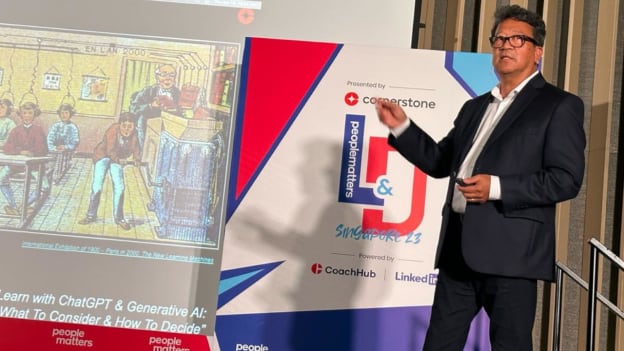ChatGPT and the L&D function: Getting AI to do the heavy lifting

Generative AI really can make HR practitioners' lives a lot easier. And not just generative AI, but the entire ecosystem of crowdsourcing knowledge through digital platforms that has enabled the technology in the first place.
L&D leaders from around Southeast Asia got a live demonstration of this potential at People Matters L&D Conference last week, where Cornerstone OnDemand's Chief Learning Officer, Marc Ramos, delivered a keynote-cum-hands-on session on the practical uses of ChatGPT and other tools for the learning and development function.
“In order to understand, conceptually, pragmatically, operationally, this big topic, we need to actually build something,” he commented – encapsulating a common theme of the conference, that learning needs to be application-based and experience-oriented.
What would you use generative AI for?
In the L&D function, one of the more fundamental challenges is typically identifying the roles that could gain the most, and the skills that would make the most impact to the effectiveness of those roles. A poll of the audience surfaced marketing as the job function that most L&D leaders believe will benefit most from AI, followed by customer service, communications, and sales.
“We can use ChatGPT to build a class from scratch, working on the input from this community,” Ramos explained. “The first part is to analyse the requirements of what's needed. So, let's try asking ChatGPT what are the top challenges for marketers, or what are the top skills needed to use AI.”
The query, put in live on the spot, turned up several skills that have been slowly gaining prominence beyond the tech industry where they originated: from data quality management, to integration of the AI tools with existing systems, to organisational readiness, analysis interpretation, and even some role-specific skills such as familiarity with software required for marketing.
Can AI really do the heavy lifting for you?
The answer to that question was an immediate 'yes' as Ramos prompted ChatGPT to create a 'comprehensive guide for Singapore companies' on leveraging AI in marketing for the retail sector. Within minutes, the platform returned a full course outline, from introduction to background, context, and structured segments. A number of leaders and practitioners in the audience began taking photographs of the screen at this point, and Ramos was quick to caution them about the limitations of what he had just demonstrated.
“Notice that I didn't talk about objectives or learning outcomes,” he said, indicating the simple prompt he had input. “A very big part of effectiveness with this innovation is the ability to actually use your own judgement and the judgements of your colleagues to tweak both your input and the output. This is just quick and easy prep work, some might say even a sloppy way to save time. But I think there are obvious advantages, and this will change our world from a content perspective, in terms of production.”
To emphasise the potential of generative AI, he gave examples of how video and image generation tools can then be used to bring the ChatGPT-generated outline into production and development, adding multimedia and interactivity to learners' experience.
What will the use of AI mean for learning experts and learners?
“This is going to change instructional design,” Ramos predicted. “Yes, from a design and production standpoint, it's not for everybody or everything. But my focus here is to really understand how it is actually changing our sector, our world, our roles, and this is something you need to be very cognisant of.”
The impact on what L&D practitioners do is one thing. But, as he also pointed out, today's AI tools open the path for entirely new ways to make learning more engaging and impactful. Although a human facilitator will still be needed at certain parts of the process to ensure that learners are really putting in the required effort and getting the expected outcomes, the entire milieu can potentially change.
“Imagine a world in which, as part of our learning activities, students can debate any topic they like within reason, where the AI can take the other side of the debate and they can fine-tune their arguments against it,” he suggested. “They can have conversations with historical figures or figures from literature. They can get help on problems that they might have to do in class or in homework, but not in a way that just gives them the answer – in a way that helps nudge the student to figure it out for themselves.”














